Hello, fellow cat lovers! If you’re lucky enough to share your life with an outdoor cat, you know that these adventurous feline friends require special care to keep them safe and happy. In this article, I will share some essential tips on how to care for an outdoor cat and ensure their well-being. Let’s dive in!
Key Takeaways:
- Providing proper identification, spaying/neutering, and vaccinations are crucial for keeping outdoor cats safe.
- Understanding outdoor cat behavior and socializing them properly can further enhance their safety.
- Building or providing a suitable shelter for outdoor cats helps protect them from the elements.
- Consistent and nutritious feeding, along with access to fresh water, is essential for outdoor cats’ health.
- Regular veterinary check-ups, parasite prevention, and grooming are vital for outdoor cat health care.
Keeping Your Outdoor Cat Safe
When it comes to keeping your outdoor cat safe, there are several important steps you can take. First and foremost, ensuring proper identification is crucial. Consider getting your cat microchipped and make sure they wear a collar with an ID tag containing your contact information. This will greatly increase the chances of being reunited with your cat if they ever go missing.
In addition to identification, it’s essential to have your outdoor cat spayed or neutered. This not only helps reduce the risk of certain health issues but also prevents them from contributing to the overpopulation of stray cats. Neutered cats are also less likely to roam and engage in aggressive behavior.
Understanding your cat’s behavior and socializing them properly is another key aspect of keeping them safe. Spend time with your cat, play with them, and provide opportunities for exercise and mental stimulation. This will help satisfy their natural instincts and reduce the likelihood of them wandering off into potentially dangerous situations.
By taking these measures to keep your outdoor cat safe, you can provide them with the protection they need while still allowing them to enjoy the outdoors.
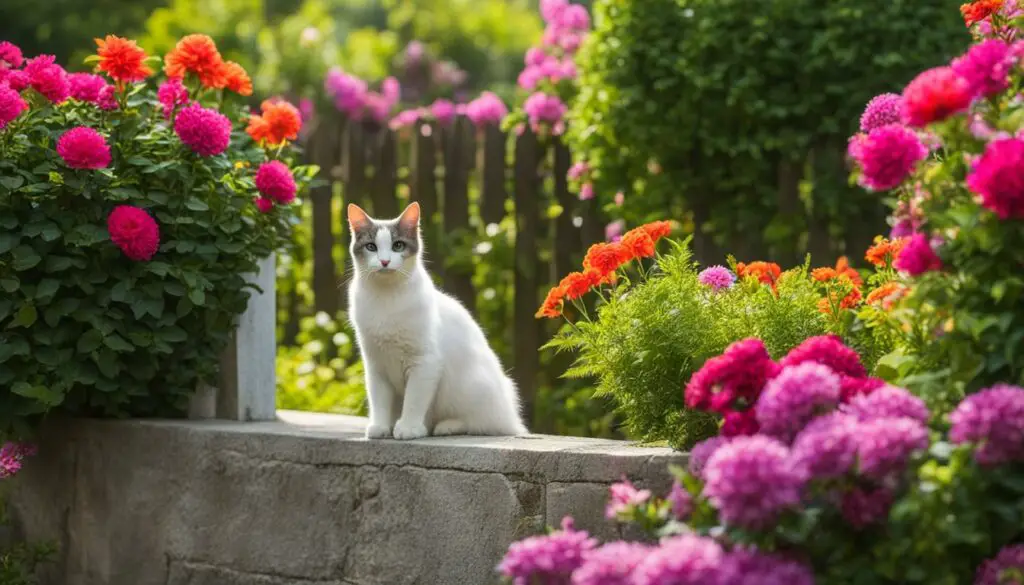
Table: Tips for Keeping Your Outdoor Cat Safe
| Tip | Description |
|---|---|
| Proper identification | Microchip your cat and ensure they wear a collar with an ID tag. |
| Spay or neuter | Reduce health risks and prevent overpopulation. |
| Understanding behavior | Learn about your cat’s behavior and provide appropriate outlets for their instincts. |
| Socialization | Spend time with your cat and provide opportunities for exercise and mental stimulation. |
Providing Shelter for Outdoor Cats
Outdoor cats need a safe and comfortable place to seek shelter from the elements. Building or providing a suitable shelter is essential for their well-being. A well-insulated cat house or catio can help protect your outdoor cat from extreme weather conditions, keeping them warm and dry.
When designing a cat shelter, it’s important to consider the size and materials. The shelter should be spacious enough for your cat to move around comfortably, with proper insulation to retain heat. Adding straw or blankets can provide extra warmth during colder months. Ensure the shelter is raised off the ground to prevent moisture from seeping in.
If you prefer a DIY approach, there are various plans available online for building a cat house or catio. Alternatively, you can purchase pre-made shelters designed specifically for outdoor cats. These shelters often come with features like removable roofs for easy cleaning and access.
Remember to place the shelter in a quiet and secure location, away from busy roads or potential dangers. Providing a shelter for your outdoor cat is an important way to ensure their safety and comfort year-round.
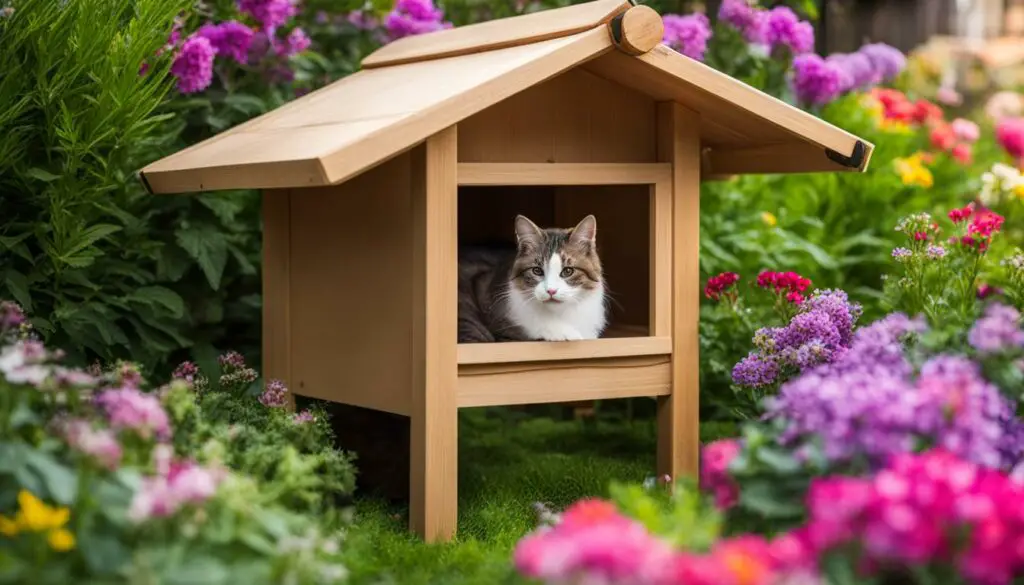
Table: Comparing Different Shelter Options
| Shelter Type | Pros | Cons |
|---|---|---|
| DIY Cat House | Customizable design, cost-effective | Requires construction skills, time-consuming |
| Pre-Made Shelter | Convenient, readily available | Limited customization options, higher cost |
| Catio | Provides a secure outdoor space, protects against predators | Requires more space, higher cost |
“A shelter is essential for outdoor cats to protect them from harsh weather conditions and provide a safe haven. Whether you choose to build a DIY cat house or invest in a pre-made shelter, ensuring your outdoor cat has a cozy retreat is crucial for their well-being.” – Dr. Emily Johnson, Veterinarian
Feeding Outdoor Cats
Feeding outdoor cats is an essential part of their care and well-being. Providing them with a consistent and nutritious diet plays a crucial role in maintaining their health and energy levels. Here are some important considerations when it comes to feeding your outdoor cat:
- Choose the right food: Opt for high-quality cat food that is specifically formulated for outdoor cats. Look for options that provide a balanced mix of protein, carbohydrates, and essential nutrients. Avoid feeding your cat with human food or dog food as it may lack the necessary nutrients.
- Establish a feeding routine: It’s important to establish a consistent feeding routine for your outdoor cat. Feed them at the same time each day to help regulate their hunger and prevent them from relying on other food sources. Avoid leaving food out all day to prevent attracting unwanted wildlife.
- Monitor portion sizes: Outdoor cats may have different dietary needs compared to indoor cats due to their increased activity levels. Consult with your veterinarian to determine the appropriate portion sizes based on your cat’s age, weight, and activity level.
- Provide fresh water: Along with proper food, fresh and clean water is essential for outdoor cats. Ensure that your cat has access to fresh water at all times, especially during hot summer days. Consider using a pet water fountain to encourage your cat to drink more water.
Remember, even though outdoor cats may have the opportunity to hunt for food, it is still important to provide them with a well-balanced diet to meet their nutritional needs. Regularly monitor your cat’s body condition and consult with a veterinarian for any specific dietary recommendations or concerns.
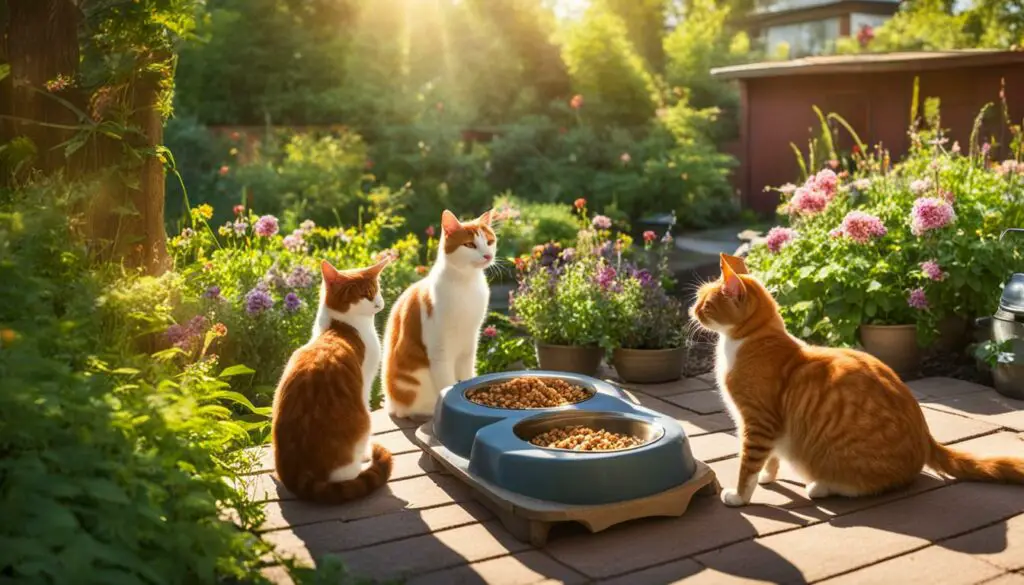
Table: Common Foods to Avoid Feeding Outdoor Cats
| Foods to Avoid | Reasons |
|---|---|
| Raw or undercooked meat | May contain harmful bacteria and parasites |
| Onions and garlic | Can cause anemia and damage to red blood cells |
| Milk and dairy products | Many cats are lactose intolerant and can experience digestive issues |
| Chocolate, caffeine, and alcohol | Contain substances that are toxic to cats and can lead to serious health problems |
Outdoor Cat Health Care
When it comes to caring for your outdoor cat, ensuring their health is a top priority. Outdoor cats are more exposed to health risks and diseases compared to indoor cats, making regular health care essential for their well-being. By taking proactive measures and working closely with your veterinarian, you can help keep your outdoor cat healthy and happy.
Regular veterinary check-ups are crucial for monitoring your outdoor cat’s overall health. These check-ups allow your veterinarian to assess your cat’s condition, detect any potential health issues early on, and provide appropriate treatment or preventive care. Vaccinations are an important aspect of health care for outdoor cats, as they help protect against common infectious diseases such as feline leukemia virus and rabies.
Parasite prevention is another vital component of outdoor cat health care. Fleas, ticks, and other parasites can pose significant risks to your cat’s well-being. Your veterinarian can recommend and prescribe appropriate flea and tick preventives to keep your outdoor cat protected. Regularly checking your cat for any signs of parasites and promptly treating any infestations is also essential.
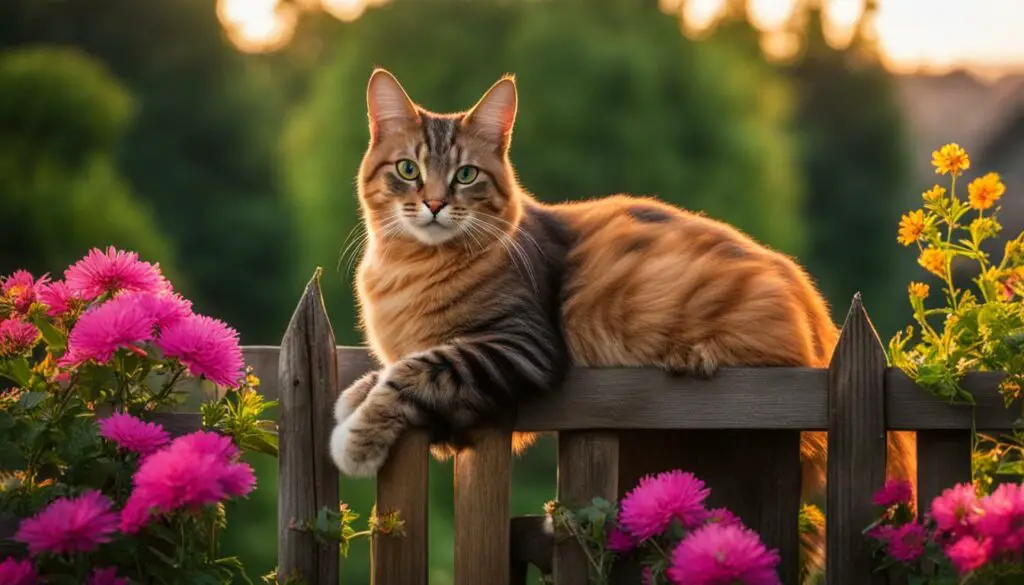
Monitoring your outdoor cat’s behavior and overall well-being is necessary for early detection of any health issues. Keep an eye out for changes in appetite, water intake, litter box habits, or any signs of discomfort or distress. If you notice anything unusual, don’t hesitate to consult with your veterinarian for further evaluation and guidance.
In summary, outdoor cat health care involves regular veterinary check-ups, parasite prevention, and monitoring your cat’s overall well-being. By prioritizing your outdoor cat’s health and addressing any health concerns promptly, you can help ensure they have a long and healthy life.
Grooming an Outdoor Cat
Proper grooming is essential for the overall health and well-being of an outdoor cat. Regular grooming not only helps to keep their coat clean and free from matting but also allows you to closely monitor their skin and check for any signs of parasites or injuries. Here are some important grooming tips to keep your outdoor cat looking and feeling their best.
Brushing Regularly
Regular brushing helps to remove loose fur and prevents matting, which can be uncomfortable for your cat. Use a cat-specific brush or comb, and gently brush the entire body, paying special attention to areas prone to matting, such as the belly and behind the ears. This not only keeps their coat healthy but also helps to reduce shedding in your home.
Checking for Parasites
Outdoor cats are more susceptible to parasites such as fleas and ticks. During the grooming session, carefully inspect your cat’s fur for any signs of these pests. Use a flea comb to comb through the fur, paying attention to areas where fleas and ticks are commonly found, such as around the neck, base of the tail, and under the arms. If you notice any parasites, consult your veterinarian for appropriate treatment options.
“Regular grooming not only helps to keep their coat clean and free from matting but also allows you to closely monitor their skin and check for any signs of parasites or injuries.”
Trimming Nails
Trimming your outdoor cat’s nails regularly helps prevent them from becoming too long and causing discomfort or injury. Use cat-specific nail clippers and gently trim the tips of the nails, being careful not to cut into the quick, which can cause bleeding. If you are unsure about how to trim your cat’s nails, consult your veterinarian or a professional groomer for guidance.
Maintaining Ear and Dental Health
In addition to grooming the coat, it’s important to pay attention to your outdoor cat’s ears and teeth. Check their ears regularly for any signs of redness, discharge, or odor, which may indicate an ear infection. Use a damp cotton ball to gently clean the outer part of the ear, but avoid inserting anything into the ear canal. As for dental health, provide your outdoor cat with dental treats or toys specifically designed to promote healthy teeth and gums.
“Regular grooming not only helps to keep their coat clean and free from matting but also allows you to closely monitor their skin and check for any signs of parasites or injuries.”
Grooming an outdoor cat is not only about keeping them looking their best but also plays a crucial role in their overall health and well-being. By dedicating time to regular grooming sessions, you can ensure that your outdoor cat stays clean, comfortable, and free from any potential health issues.
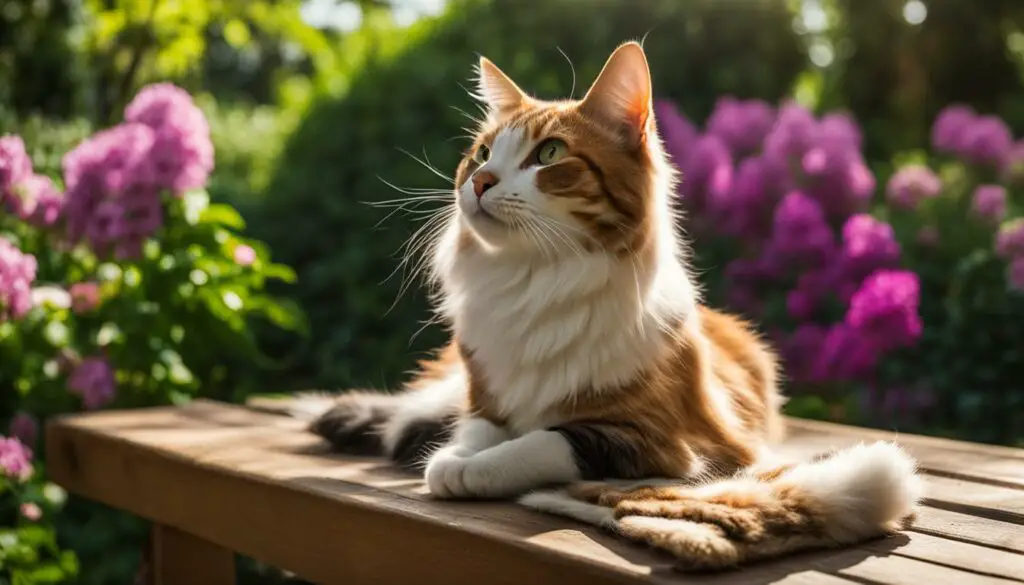
Keeping Outdoor Cats Safe from Harmful Plants
When caring for an outdoor cat, it’s important to be aware of the potential dangers they may encounter in their environment. One such danger is toxic plants, which can pose a serious risk to your cat’s health if ingested. To keep your outdoor cat safe from harmful plants, it’s essential to understand their behavior and take necessary precautions.
Outdoor cats are known for their curious nature and may come into contact with a variety of plants during their explorations. Some common plants, such as lilies, azaleas, and oleanders, can be highly toxic to cats and should be avoided in their roaming areas. To ensure your cat’s safety, it’s crucial to familiarize yourself with a list of toxic plants for cats and remove them from your outdoor cat’s environment if necessary.
Remember, prevention is key when it comes to keeping your outdoor cat safe from harmful plants. Take the time to identify and remove any toxic plants in your cat’s roaming area, and provide them with alternative vegetation to explore.
Additionally, it can be helpful to create designated areas with cat-friendly plants that are safe for your outdoor cat to interact with. These plants can provide mental stimulation and enrichment for your cat while ensuring their well-being. Some examples of cat-friendly plants include catnip, wheatgrass, and catmint.
Creating a Safe Outdoor Environment
In addition to managing the presence of harmful plants, creating a safe outdoor environment for your cat is essential. Consider implementing the following measures:
- Secure boundaries: Ensure your cat’s outdoor space is enclosed with secure fencing or cat-proof barriers to prevent them from wandering too far.
- Provide supervision: Whenever possible, supervise your outdoor cat’s activities to minimize potential risks and intervene if needed.
- Regularly inspect the area: Regularly inspect your outdoor cat’s roaming area for any potential hazards, such as sharp objects or poisonous substances.
By being proactive and taking these precautions, you can create a safe and enjoyable outdoor environment for your cat to explore while minimizing the risks posed by harmful plants.

Using a GPS Tracker for Outdoor Cats
As an outdoor cat owner, ensuring the safety and well-being of your furry friend is a top priority. One valuable tool that can provide peace of mind is a GPS cat tracker and activity monitor. These devices allow you to keep track of your cat’s location in real-time and monitor their daily activities.
With a GPS tracker, you can easily pinpoint your cat’s whereabouts if they wander too far from home. If your cat tends to roam beyond your property, this can be especially useful in quickly locating them and bringing them back safely. Additionally, the tracker can provide insights into your cat’s behavior and patterns, giving you a better understanding of their daily routines.
When choosing a GPS tracker, look for features such as real-time tracking, geofencing capabilities, and long battery life. Some trackers even offer activity monitoring, allowing you to track your cat’s movements and exercise levels. This can be particularly helpful in ensuring that your outdoor cat stays active and maintains a healthy lifestyle.
| Benefits of Using a GPS Tracker for Outdoor Cats |
|---|
| 1. Provides real-time tracking of your cat’s whereabouts. |
| 2. Allows you to set up geofences to receive alerts if your cat strays too far. |
| 3. Gives insights into your cat’s behavior and activity levels. |
| 4. Helps locate your cat quickly if they go missing. |
Overall, a GPS tracker can be a valuable investment for outdoor cat owners, offering peace of mind and the ability to keep a close eye on your cat’s whereabouts and activities. Remember to consult with your veterinarian for personalized advice on using a GPS tracker and other measures to ensure the safety and well-being of your outdoor cat.
![]()
Training Your Outdoor Cat to Come Home
Training your outdoor cat to come home on command is an important skill that can help keep them safe. By teaching them to respond to your call, you can prevent them from getting lost or encountering potential dangers. Here are some tips to help you train your cat to come home:
1. Start in a familiar environment
Begin the training process in a familiar and secure area, such as your backyard or a designated outdoor space. This will help your cat feel more comfortable and confident during the training sessions.
2. Use positive reinforcement
Positive reinforcement is key to successful training. When your cat comes to you after you call them, reward them with praise, treats, or their favorite toy. This will associate coming home with positive experiences and encourage them to repeat the behavior.
3. Use a consistent cue
Choose a specific cue or command to signal your cat to come home. It can be a verbal call, such as their name, or a specific sound, like a whistle. Use this cue consistently during the training sessions to help your cat establish the connection between the cue and the action of returning home.
Remember that training takes time and patience, so be consistent and keep the training sessions short and positive. With practice and reinforcement, your outdoor cat will learn to come home when called and enjoy the freedom of the outdoors while staying safe.
| Training Tips: | Benefits: |
|---|---|
| Start in a familiar environment | Helps your cat feel secure and confident during training. |
| Use positive reinforcement | Associates coming home with positive experiences. |
| Use a consistent cue | Helps your cat establish the connection between the cue and returning home. |
Train your outdoor cat to come home and enjoy the peace of mind that comes with knowing they will respond to your call. Remember that each cat is unique and may require different training approaches, so tailor your methods to suit your cat’s personality and needs.
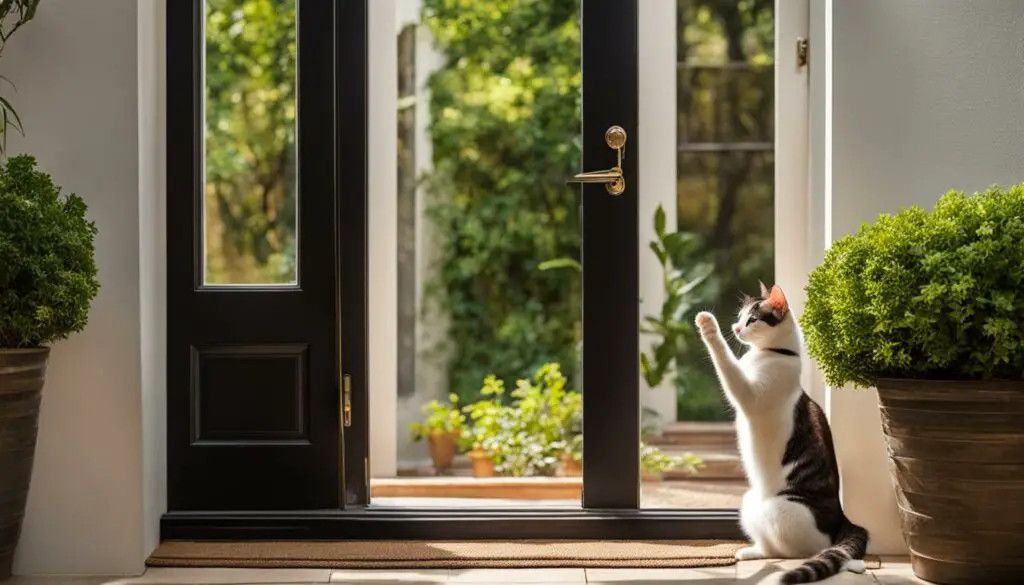
Building a Cat Enclosure
Building a cat enclosure, also known as a catio, is a fantastic way to provide your outdoor cat with a safe and controlled outdoor space. These enclosures offer numerous benefits, including protection from predators, preventing the spread of diseases, and reducing the risk of accidents. By following a few simple steps, you can create a customized and secure environment for your furry friend.
Firstly, assess the available space in your backyard and determine the size and design of the cat enclosure. Consider the number of cats you have, their activity levels, and any specific requirements they may have. It’s important to provide enough space for your cat to move around comfortably, including climbing structures and resting areas.
Next, gather the necessary materials for building the cat enclosure. You will need sturdy and weather-resistant materials such as wood or PVC pipes for the frame, strong wire mesh for the walls, and a secure door for easy access. Ensure that all materials are pet-safe and free from any harmful chemicals or sharp edges.
Once you have your materials ready, start constructing the frame of the cat enclosure. You can choose to build a freestanding structure or attach it to an existing wall or fence. Make sure the frame is secure and stable, taking into account any potential risks such as strong winds or climbing hazards.
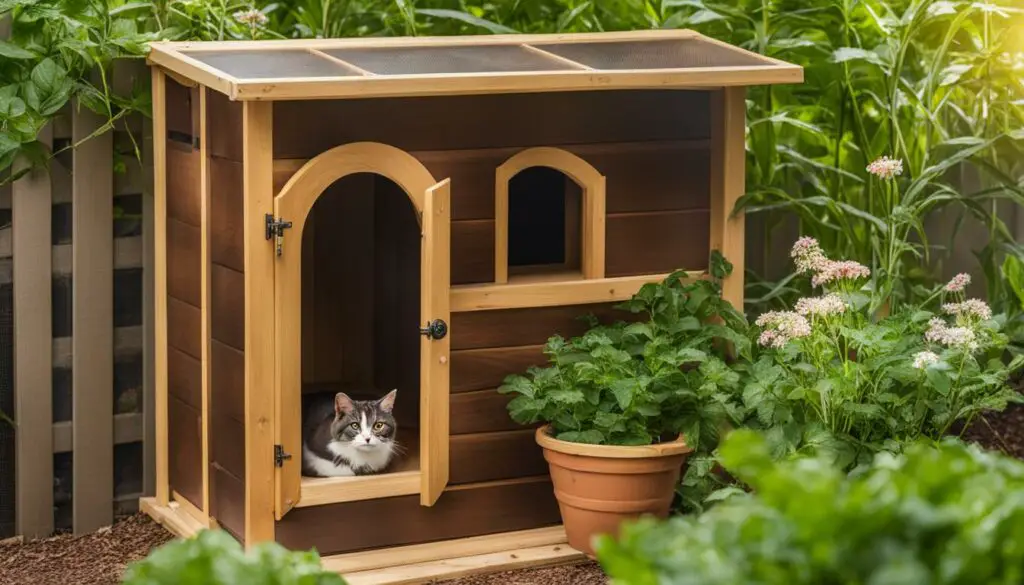
After the frame is complete, attach the wire mesh to create the walls of the enclosure. It’s essential to use a durable and tightly woven mesh that can withstand any attempts of escape or intrusion. Secure the mesh firmly to the frame, ensuring there are no gaps or loose ends that could pose a threat.
Finally, add the finishing touches to the cat enclosure. Include various elements such as shelves, perches, scratching posts, and toys to create a stimulating and enriching environment for your cat. Consider adding plants or a window perch to provide your cat with a view of the outside world.
By building a cat enclosure, you can offer your outdoor cat the freedom to enjoy the outdoors while ensuring their safety and well-being. It’s a rewarding project that will provide years of enjoyment and peace of mind for both you and your feline companion.
Keeping Your Outdoor Cat Warm in Winter
As the cold weather sets in, it’s important to take extra precautions to keep your outdoor cat warm and safe. Here are some tips to ensure your feline friend stays cozy during the winter months.
1. Providing Insulated Shelter
A well-insulated shelter is crucial for protecting your outdoor cat from the freezing temperatures. Consider using a cat house or building a shelter using insulated materials such as styrofoam or straw. Ensure that the shelter is raised off the ground to prevent dampness and use a flap or door to keep cold drafts out. Place warm bedding inside, such as blankets or heated pads specifically designed for pets. Regularly check the shelter for any signs of damage or leaks, and make necessary repairs to maintain its insulation.
2. Heated Beds and Pads
Another option to keep your outdoor cat warm is by providing them with a heated bed or pad. These devices provide a constant source of warmth and can be placed inside their shelter or other cozy spots around your yard. Make sure to choose products that are designed specifically for pets and follow the manufacturer’s instructions for safe usage. It’s important to regularly monitor the heated beds or pads to ensure they are functioning properly and not overheating.
3. Access to Warm Food and Water
During colder months, it’s essential to provide your outdoor cat with warm food and water. Consider using heated bowls or water dispensers to prevent their water from freezing. Additionally, feed them warm meals and include high-quality, nutritious ingredients that will help keep their body temperature up. However, be cautious not to leave wet food outside for too long, as it can spoil quickly in cold weather. Monitor their food and water supply regularly to ensure they have access to fresh and warm provisions.
By following these tips, you can help your outdoor cat stay comfortable and safe throughout the winter season. Remember, the well-being of your furry friend should always be a top priority, especially in extreme weather conditions.

Why Indoor Cats Live Longer
Indoor cats generally have longer lifespans compared to outdoor cats due to reduced exposure to risks such as accidents, diseases, and predators. While outdoor cats may enjoy the freedom of exploring the great outdoors, they also face numerous dangers that can significantly impact their health and lifespan.
One of the main reasons why indoor cats live longer is their decreased risk of accidents. Outdoor cats are vulnerable to traffic accidents, harmful encounters with other animals, and even injuries from fights. By keeping cats indoors, we can ensure they are protected from these potential hazards, reducing the likelihood of severe injuries or fatalities.
Indoor cats also have a lower risk of contracting infectious diseases. Outdoor cats are more likely to come into contact with infected animals, parasites, and contaminated environments. This increases the chances of contracting serious illnesses such as feline leukemia, feline immunodeficiency virus, and parasites like fleas and ticks. By keeping cats indoors, we can minimize their exposure to these health risks and provide them with a safer and healthier environment.
Although indoor cats live longer on average, it’s important to note that outdoor cats can also lead long and healthy lives with proper care and precautions. Providing outdoor cats with necessary vaccinations, regular veterinary check-ups, and monitoring their overall health can help minimize risks and ensure their well-being. By striking a balance between safety and outdoor enrichment, we can give our feline companions the best of both worlds.
Conclusion
In conclusion, caring for an outdoor cat requires attention to their safety, health, and well-being. By following the essential tips outlined in this article, you can provide the proper care that your outdoor cat needs to thrive.
Keeping your outdoor cat safe should be a top priority. Ensure they are properly identified with a collar and tags, spayed or neutered, and vaccinated to prevent any health risks. Understanding their behavior and socializing them properly can also contribute to their overall safety.
Providing shelter for your outdoor cat is essential, especially during extreme weather conditions. Building or providing a suitable shelter, such as a well-insulated cat house or catio, will help keep them warm and comfortable.
Feeding your outdoor cat a consistent and nutritious diet is crucial for their health. Consider using automatic feeders or timed feeding to ensure they have access to food throughout the day. Additionally, regular veterinary check-ups, parasite prevention, and grooming are necessary for maintaining their overall well-being.
While outdoor cats may face more risks compared to indoor cats, with proper care and precautions, they can still lead long and healthy lives. By training your outdoor cat to come home, using a GPS tracker, and creating a cat enclosure, you can provide a controlled and protected environment for them to explore and relax.
In summary, caring for an outdoor cat requires a combination of attention to safety, health, and well-being. By implementing the tips outlined in this article, you can ensure that your outdoor cat lives a fulfilling and happy life.
FAQ
How can I keep my outdoor cat safe?
You can keep your outdoor cat safe by ensuring they are properly identified, spayed or neutered, and vaccinated. Understanding their behavior and socializing them properly can also contribute to their safety.
What kind of shelter should I provide for my outdoor cat?
It’s important to provide a suitable shelter, such as a well-insulated cat house or catio, to protect your outdoor cat from the elements and keep them warm and comfortable during extreme weather conditions.
What should I feed my outdoor cat?
Outdoor cats require a consistent and nutritious diet. Providing them with proper food and fresh water is essential. You can consider using automatic feeders or timed feeding to ensure they have access to food throughout the day.
How can I ensure the health of my outdoor cat?
Regular veterinary check-ups, parasite prevention, and monitoring their overall health are crucial for maintaining the well-being of your outdoor cat. Stay on top of vaccinations and consult with your veterinarian for any specific health concerns.
How should I groom my outdoor cat?
Regular brushing and checking for any signs of fleas, ticks, or injuries can help maintain the coat of your outdoor cat. It’s important to use cat-friendly grooming tools and techniques for their comfort and well-being.
Are there any plants that are toxic to outdoor cats?
Yes, some plants can be toxic to cats if ingested. It’s important to be aware of these plants in your outdoor cat’s environment and take necessary precautions to keep them away from them. Keep a list of toxic plants for cats and ensure they are not present in your outdoor cat’s roaming area.
Should I use a GPS cat tracker for my outdoor cat?
Using a GPS cat tracker can provide peace of mind for outdoor cat owners. These devices allow you to track your cat’s location in real-time and receive alerts if they roam too far from home. They can also provide valuable information about your cat’s activities and behavior.
How can I train my outdoor cat to come home on command?
Training your outdoor cat to come home on command is an important skill that can help keep them safe. Positive reinforcement techniques, such as using treats and rewards, can be used to train your cat to respond to your call and return home when needed.
Should I build a cat enclosure for my outdoor cat?
Yes, building or installing a cat enclosure, also known as a catio, provides a safe and controlled outdoor space for your cat to enjoy. It can give your outdoor cat a protected area to explore and relax while keeping them safe from potential dangers.
How can I keep my outdoor cat warm in winter?
Winter weather can be harsh for outdoor cats. You can ensure your cat stays warm by providing shelter with insulation, heated beds, and access to warm food and water. It’s important to keep an eye on their well-being during colder months.
Why do indoor cats live longer than outdoor cats?
Indoor cats generally have longer lifespans compared to outdoor cats due to reduced exposure to risks such as accidents, diseases, and predators. However, with proper care and precautions, outdoor cats can also lead long and healthy lives.








